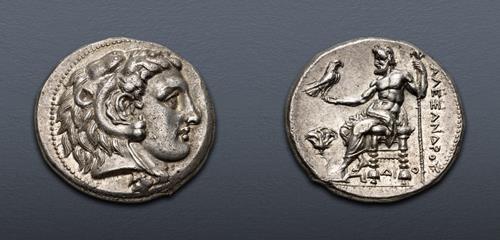
|
PTOLEMAIC KINGS of EGYPT. Ptolemy I Soter. As satrap, 323-305/4 BC. AR Tetradrachm (26mm, 17.18 g, 12h). In the name and types of Alexander III of Macedon. Memphis or Alexandreia mint. Struck circa 323-317 BC.
CNG Feature Auction 120
Lot: 498. Estimated: $ 3 000
Greek, Coin-in-Hand Video, Silver
Sold For $ 4 750. This amount does not include the buyer’s fee.
Go to Live
|
|
PTOLEMAIC KINGS of EGYPT. Ptolemy I Soter. As satrap, 323-305/4 BC. AR Tetradrachm (26mm, 17.18 g, 12h). In the name and types of Alexander III of Macedon. Memphis or Alexandreia mint. Struck circa 323-317 BC. Head of Herakles right, wearing lion skin / AΛEΞANΔPOY, Zeus Nikephoros seated left; rose in left field, ΔI-O below throne. CPE 19; Svoronos –; Zervos Issue 2C, dies 206/f; Price 3971 var. (position of letters on rev.). Lightly toned, much underlying luster. Choice EF. An exceptional example.
Ex Triton XXII (8 January 2019), lot 399.
O. Zervos, in his original 1967 ANS Museum Notes article, thought these early Egyptian Alexanders were struck much earlier, but he later clarified his position in his 1974 Ph.D. dissertation, stating that he thought that they began in 324-322 BC, though most likely after Alexander III’s death. His analysis of the hoards somewhat supports his contention, but the evidence is not conclusive. M. Price, in his 1991 corpus on the Alexander coinage, thought that the minting of Alexanders began upon the conquest of Egypt in 332, but this early date is not supported by the evidence. G. Le Rider, in his 1997 review Alexander's coinage and finances, agreed with a late date for the beginning of Alexanders in Egypt, though slightly earlier, circa 325/4 BC. C. Lorber, in an article in NC 2005, came to a similar conclusion regarding the late start of production, agreeing with Zervos that is was more likely after Alexander's death, circa 323 BC. Zervos, Price, and Lorber all think that the coinage began at Memphis, which had produced imitation Athenian tetradrachms under the Persians, and was later transferred to Alexandreia, while Le Rider thought it was at Alexandreia from the onset. Undoubtedly, the construction of Alexandreia was completed during the reign of Kleomenes, Ptolemy's predecessor as satrap, and Le Rider argued that Kleomenes would have established his headquarters there, as well as his mint. Although Lorber, in CPE, attributes the initial issues to Memphis, the question remains open. All examples of this early Ptolemaic issue were struck from dies of remarkable beauty, the present specimen exemplifying this artistry and boasting a splendid state of preservation.
The final winners of all CNG 120 lots will be determined at the live online sale that will be held on 11-12 May 2022. CNG 120 – Session Two – Greek Coinage (Part 2) through Roman Provincial Coinage will be held Wednesday afternoon, 11 May 2022 beginning at 2:00 PM ET.
Winning bids are subject to a 20% buyer's fee for bids placed on this website and 22.50% for all others.
We recognize that our users may have various Internet Browsers and Operating Systems. We like our visitors to have the best possible experience when using our bidding platform. However, we do recognize that it is impossible to develop applications that work identically, efficiently and effectively on all web browsers. The CNG bidding platform supports the latest stable major version and the stable previous version of Mozilla Firefox and Chrome.
|
